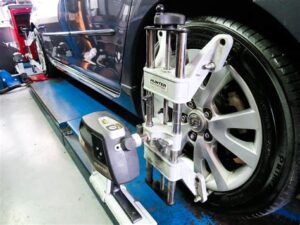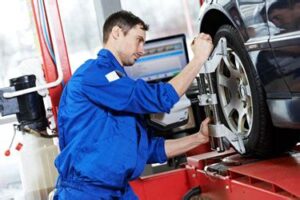When it comes to maintaining the performance and safety of your vehicle, understanding car alignment symptoms is crucial. Misalignment can lead to a range of issues, from uneven tire wear to compromised handling, which can significantly impact your driving experience. In this article, we will explore the common car alignment symptoms you shouldn’t ignore and the importance of routine alignment checks. You’ll learn how poor alignment affects your vehicle’s handling and the signs of uneven tire wear that could indicate a misalignment issue. Don’t let alignment problems jeopardize your safety on the road; read on to discover the importance of keeping your vehicle in top condition and the consequences of overlooking these critical warning signs.
Common Car Alignment Symptoms You Shouldn’t Ignore
Proper car alignment is essential for safe and efficient vehicle operation. Ignoring signs of misalignment can lead to further vehicle damage and increased repair costs. Here are some common symptoms that indicate your vehicle may need an alignment check:
- Uneven Steering Wheel Position: If your steering wheel is off-center when driving straight, it might indicate that your wheels are misaligned.
- Vehicle Pulling to One Side: A clear sign of misalignment is when your vehicle tends to drift to the left or right even when you’re not steering.
- Vibration in the Steering Wheel: Feelings of vibration or shaking in the steering wheel while driving can point to potential alignment issues.
- Increased Tire Wear: Check for uneven tire wear, as misaligned wheels can cause tires to wear out faster in some areas than others.
- Difficulty in Handling: If your vehicle feels hard to control, it could be a result of poor car alignment, affecting handling and stability.
Being aware of these symptoms can help you maintain your vehicle in its best condition and ensure a safe driving experience. If you notice any of these signs, it may be time to consult with a professional about your car alignment.
How Poor Car Alignment Affects Vehicle Handling
Poor car alignment can significantly compromise your vehicle’s handling and overall performance. When your car’s wheels are not aligned correctly, it can lead to a range of handling issues that can make driving dangerous and uncomfortable. Here are some ways in which poor car alignment can affect vehicle handling:
| Issue | Description |
|---|---|
| Steering Wheel Vibration | When the wheels are misaligned, you may experience excessive vibrations in the steering wheel, making it difficult to steer the vehicle smoothly. |
| Pulling to One Side | A misaligned vehicle often pulls to one side, requiring constant correction to keep it on a straight path, which can be tiring and distracting. |
| Difficulty in Steering | With improper alignment, the steering may become unresponsive or overly sensitive, making it hard to maintain control, especially during turns. |
| Uneven Response | Misalignment can lead to uneven handling where one side responds differently than the other, affecting the overall stability of the vehicle. |
| Increased Stopping Distance | When wheels are out of alignment, it can hinder effective braking, increasing the distance needed to stop the vehicle safely. |
In addition to affecting steering and handling, poor car alignment may lead to premature wear on suspension components and tires. This not only incurs additional repair costs but can also compromise safety. Regular checks are essential to ensure that your vehicle maintains proper alignment, enhancing driving comfort and safety. By addressing alignment issues promptly, you can avoid further complications that may arise from neglecting such a critical aspect of vehicle maintenance.
Signs Of Uneven Tire Wear Indicating Misalignment
One of the most telling signs of poor car alignment is uneven tire wear. When your vehicle’s wheels are not properly aligned, it can lead to various patterns of tire wear that are easy to spot. Here are some common signs to look out for:
- Inner or Outer Edge Wear: If you notice that the inner or outer edges of your tires have significantly more wear than the center, it can indicate that your wheels are misaligned.
- One-Sided Wear: Uneven wear on one side of the tire compared to the other can suggest that your car alignment is off, causing the vehicle to pull in one direction.
- Excessive Camber Wear: A noticeable tilt in the alignment can manifest as excessive wear on either the inside or outside of the tire tread, often seen when viewing the vehicle straight on.
- Scalloping or Cupping: If your tires have a wavy or irregular surface, this can be a sign of misalignment along with suspension issues. This wear pattern can also lead to a noisy ride.
Monitoring your tires regularly for these symptoms can help you catch alignment issues early, ensuring a safer ride and potentially saving money on new tires.
The Importance Of Regular Car Alignment Checks
Maintaining proper car alignment is crucial for several reasons. Regular alignment checks ensure that your vehicle’s wheels are positioned correctly, which plays a significant role in overall vehicle performance and safety. Here are some key benefits of making regular alignment checks a priority:
- Enhanced Tire Longevity: Proper alignment minimizes tire wear and extends their life, saving you money in the long run.
- Improved Fuel Efficiency: When your wheels are aligned, your vehicle uses fuel more efficiently, leading to savings at the pump.
- Better Handling: A well-aligned car provides better control and stability, making for a safer driving experience.
- Increased Safety: Regular checks can help identify potential issues before they become serious problems, reducing the risk of accidents.
- Comfortable Ride: Proper alignment reduces vibrations and pulling, creating a smoother and more comfortable driving experience.
Ignoring car alignment can lead to a host of problems, such as uneven tire wear, compromised safety, and expensive repairs. Therefore, scheduling routine alignment checks as part of your vehicle maintenance is essential. It is advisable to have your alignment checked every 6,000 miles or whenever you notice any signs of misalignment.
Understanding The Consequences Of Ignoring Car Alignment Issues
Neglecting car alignment can lead to a variety of adverse effects that not only compromise the performance of your vehicle but can also significantly impact your safety on the road. One of the most immediate consequences is the uneven wear on your tires, which can lead to premature tire replacement. This not only incurs unnecessary costs but also reduces your vehicle’s fuel efficiency as improperly aligned tires create additional drag.
Additionally, poor car alignment can affect the handling of your vehicle, making it less responsive to steering inputs. This diminished control can greatly increase the risk of accidents, especially in critical driving situations such as emergency maneuvers. If the alignment is substantially out of whack, you might also experience a shaking steering wheel, which is often an alarming indication that your vehicle requires urgent inspection.
Furthermore, ignoring car alignment issues can lead to damage in other components of your vehicle, such as the suspension and steering systems. Over time, these issues accumulate, causing potentially expensive repairs and reducing the overall lifespan of your vehicle. In extreme cases, it may even result in failure during inspections, costing you more in fines and repairs.
Staying proactive about car alignment checks is essential. Regular maintenance will not only ensure a smoother drive and enhance your vehicle’s efficiency but also keep you and your fellow road users safe.
Frequently Asked Questions
What are the common symptoms of poor car alignment?
Common symptoms include uneven tire wear, the car pulling to one side, the steering wheel being off-center, and vibrations in the steering wheel.
How can I tell if my car needs an alignment?
If you notice your car pulling to one side or if the steering wheel is not centered while driving straight, it’s a strong indication that your car may need an alignment.
What causes misalignment in cars?
Misalignment can be caused by hitting potholes, curbs, or other obstacles, as well as by general wear and tear over time.
Can poor alignment affect my car’s fuel efficiency?
Yes, improper alignment can lead to increased rolling resistance, which can negatively impact fuel efficiency.
How often should I check my car’s alignment?
It’s recommended to check your alignment at least once a year or any time you notice symptoms. Regular maintenance is also crucial after any significant impact or suspension repairs.
What are the long-term effects of driving with misaligned wheels?
Long-term effects include uneven tire wear, which can lead to costly tire replacements, and potential damage to suspension components over time.
Is a wheel alignment a costly repair?
The cost of a wheel alignment can vary by location and service provider, but it is generally considered a cost-effective maintenance service compared to the potential expenses of tire replacement and suspension repairs.





